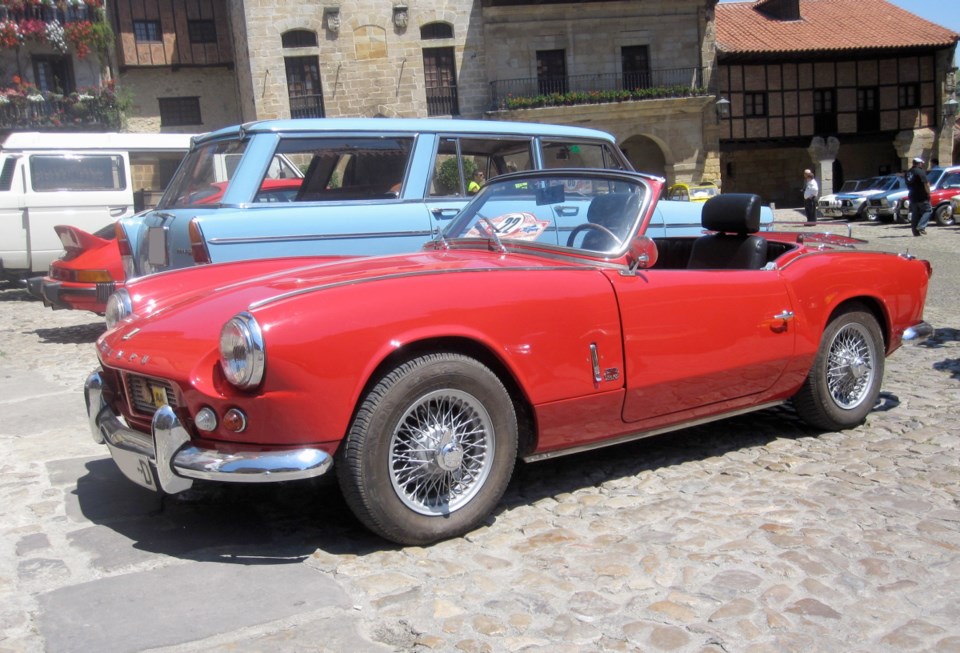When British Motor Corp. introduced the tiny Austin-Healey Sprite in 1958 to provide an entry-level car for first-time sports-car buyers, it caught the immediate attention of Standard Triumph Co. This new car was to fill the market niche the T-Series MGs had satisfied before it was replaced by the MGA.
The Sprite was very popular, a fact not lost on Standard Triumph because it didn’t have a competitor for it. Its TR3 was a little expensive for first-timers, so it decided it had to launch a Sprite competitor. And it wanted it to be a better car than the Sprite.
Like BMC, Standard Triumph used its corporate parts bin to create its new car. Its 1963 Sprite fighter was called the Spitfire, after the Second World War Spitfire fighter plane. And as Standard Triumph vowed, it was a more technically advanced car.
Like the Sprite, it inherited much from small economy sedans, and although by this time Standard Triumph had become part of truck builder Leyland Motors, the Spitfire was still a Standard Triumph product.
The Spitfire’s basic components came from the Triumph Herald sedan introduced in 1959, with a 948-cc, 38-horsepower overhead-valve four that started life in the 1953 Standard Eight with 803 cc and 26 horsepower. By the time it got into the Spitfire, it was up to 1.1 litres and 63 horsepower, thanks in part to twin SU carburetors.
This was adequate for the Spitfire’s weight of only 705 kilograms. The transmission was a floor-shifted, four-speed manual with the top three synchronized.
It got class-leading, fully independent suspension by using the Herald’s A-arms, coil springs and anti-roll bar in front, and swing axles and lateral leaf spring at the rear. When introduced, the rear suspension inspired an English writer to pen one of the most memorable lines in automotive journalism: ”Hark the Herald’s axles swing.”
The semi-unit construction Spitfire’s welded steel body was bolted to a backbone frame that split into a “Y” front and rear. The front Y accommodated the engine/transmission, and the rear one the chassis-mounted differential. Brakes were front discs and rear drums.
Steering was rack-and-pinion with a turning circle of only 7.3 metres, shorter than the famously short-turning London Cab’s. It gave wonderful manoeuvrability and easy parking.
With an overall length of just 3,683 mm, the Spitfire was quite small. Styled by Italian Giovanni Michelotti, its tiny 5.20 X 13 tires seemed just right. For maintenance, the entire hood and fender assembly tilted forward.
Performance was good for its class, with Road & Track reporting zero to 100 km/h in 15.5 seconds and 145 km/h top speed. The Sprite took 18.3 to 100 and topped out at 137 km/h.
Optional and welcome overdrive operating on third and fourth gears arrived for 1964, as did standard knock-off wire-spoke wheels, The 1965 Mark 2 version Spitfire with four more horsepower, now 67, although performance remained substantially unchanged. An optional fibreglass hardtop became available.
The Spitfire was joined by the Hardtop GT6 in 1967, a handsome fastback “mini E-Type Jaguar” coupe with the Triumph 2000 sedan’s inline six, essentially the four with two cylinders added. With 2.0 litres and 95 horsepower, it gave much better performance than the Spitfire. Zero to 100 km/h was 12.3 seconds and top speed 172 km/h.
The GT6 Mark 2 coupe arrived two years later, with superior fully articulated rear suspension replacing the Spitfire’s swing axles. It went through a Mark 3 version before being discontinued in 1973.
Meanwhile, the Spitfire Mark 3 arrived in 1967 with a slight restyling and raised front bumper to meet U.S. bumper height regulations. It now had the 75-horsepower, 1.3-litre overhead-valve four from the Triumph 1300 front-drive sedan.
The Mark IV (now using Roman numerals) superseded the Mark 3 for 1971. It replaced the swing axles with a fully articulated independent rear suspension à la the GT6. The transmission was now fully synchronized, and Michelotti refreshed the body with a squared-off TR6-style tail.
By this time, engine modifications to meet North American emissions regulations were reducing power. To retain performance, North American Mark IVs got 1.5 litres in 1973 (others got it for 1975), making it the Spitfire Mark IV 1500. Even with the larger engine, power was still only 57, although now quoted in the more realistic Society of Automotive Engineers net rather than SAE gross.
This carried the Spitfire through its last five years. It was discontinued in August 1980 as debt-ridden British-Leyland was phasing out sports cars. In a remarkably long 18-year lifetime, more than 300,000 were built.



